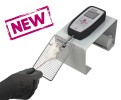Authors
K Herline, F Prelli, P Mehta, C MacMurray, F Goñi, T Wisniewski
Lab
Journal
Alzheimer's Research & Therapy
Abstract
Background Alzheimer’s disease (AD) is characterized by physiologically endogenous proteins amyloid beta (Abeta) and tau undergoing a conformational change and accumulating as soluble oligomers and insoluble aggregates. Tau and Abeta soluble oligomers, which contain extensive beta-sheet secondary structure, are thought to be the most toxic forms. The objective of this study was to determine the ability of TWF9, an anti-beta-sheet conformation antibody (abetaComAb), to selectively recognize pathological Abeta and phosphorylated tau in AD human tissue compared with cognitively normal age-matched controls and to improve the performance of old 3xTg-AD mice with advanced pathology in behavioral testing after acute treatment with TWF9.
Methods In this study, we used immunohistochemistry, immunoprecipitation, and enzyme-linked immunosorbent assay (ELISA) to characterize TWF9 specificity. We further assessed cognitive performance in old (18–22 months) 3xTg-AD mice using both a Barnes maze and novel object recognition after intraperitoneal administration of TWF9 (4 mg/kg) biweekly for 2 weeks before the start of behavioral testing. Injections continued for the duration of the behavioral testing, which lasted 2 weeks.
Results Histological analysis of TWF9 in formalin-fixed paraffin-embedded human control and AD (ABC score: A3B3C3) brain tissue revealed preferential cytoplasmic immunoreactivity in neurons in the AD tissue compared with controls (p_<_0.05). Furthermore, ELISA using oligomeric and monomeric Abeta showed a preferential affinity for oligomeric Abeta. Immunoprecipitation studies showed that TWF9 extracted both phosphorylated tau (p_<_0.01) and A_ (p_<_0.01) from fresh frozen brain tissues. Results show that treated old 3xTg-AD mice have an enhanced novel object recognition memory (p_<_0.01) and Barnes maze performance (p_=_0.05) compared with control animals. Overall plaque burden, neurofibrillary tangles, microgliosis, and astrocytosis remained unchanged. Soluble phosphorylated tau was significantly reduced in TWF9-treated mice (p_<_0.05), and there was a trend for a reduction in soluble Abeta levels in the brain homogenates of female 3xTg-AD mice (p_=_0.06).
Conclusions This study shows that acute treatment with an abetaComAb can effectively improve performance in behavioral testing without reduction of amyloid plaque burden, and that peripherally administered IgG can affect levels of pathological species in the brain.
BIOSEB Instruments Used:
Grip strength test (BIO-GS3)

 Pain - Thermal Allodynia / Hyperalgesia
Pain - Thermal Allodynia / Hyperalgesia Pain - Spontaneous Pain - Postural Deficit
Pain - Spontaneous Pain - Postural Deficit Pain - Mechanical Allodynia / Hyperalgesia
Pain - Mechanical Allodynia / Hyperalgesia Learning/Memory - Attention - Addiction
Learning/Memory - Attention - Addiction Physiology & Respiratory Research
Physiology & Respiratory Research
 Pain
Pain Central Nervous System (CNS)
Central Nervous System (CNS) Neurodegeneration
Neurodegeneration Sensory system
Sensory system Motor control
Motor control Mood Disorders
Mood Disorders Other disorders
Other disorders Muscular system
Muscular system Joints
Joints Metabolism
Metabolism Cross-disciplinary subjects
Cross-disciplinary subjects Happy new year 2025
Happy new year 2025 